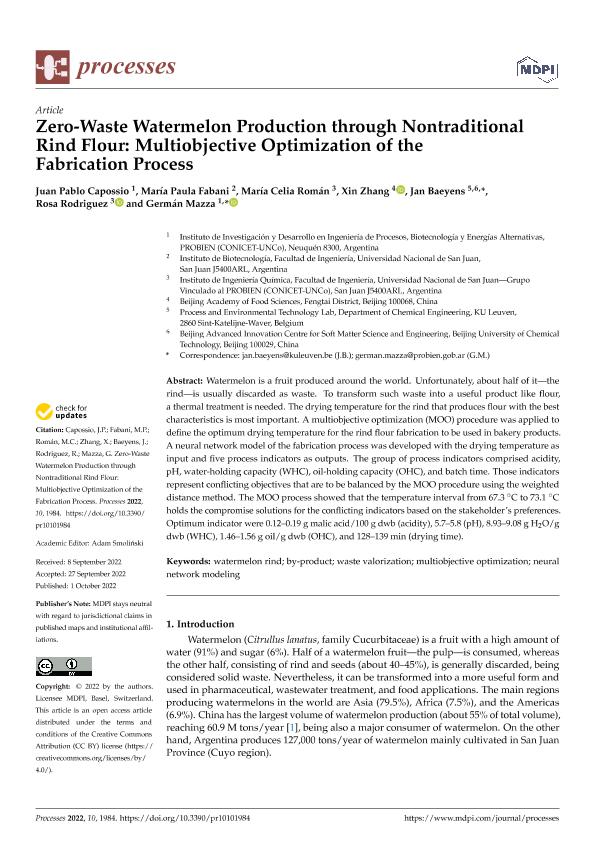Artículo
Zero Waste Watermelon Production through Non-Traditional Rind Flour: Multi-Objective Optimization of the Fabrication Process
Capossio, Juan Pablo ; Fabani, Maria Paula
; Fabani, Maria Paula ; Román Barón, María Celia
; Román Barón, María Celia ; Zhang, Xin; Baeyens, Jan; Rodriguez, Rosa Ana
; Zhang, Xin; Baeyens, Jan; Rodriguez, Rosa Ana ; Mazza, German Delfor
; Mazza, German Delfor
 ; Fabani, Maria Paula
; Fabani, Maria Paula ; Román Barón, María Celia
; Román Barón, María Celia ; Zhang, Xin; Baeyens, Jan; Rodriguez, Rosa Ana
; Zhang, Xin; Baeyens, Jan; Rodriguez, Rosa Ana ; Mazza, German Delfor
; Mazza, German Delfor
Fecha de publicación:
10/2022
Editorial:
MDPI
Revista:
Processes
ISSN:
2227-9717
Idioma:
Inglés
Tipo de recurso:
Artículo publicado
Clasificación temática:
Resumen
Watermelon is a fruit produced around the world. Unfortunately, about half of it—the rind—is usually discarded as waste. To transform such waste into a useful product like flour, a thermal treatment is needed. The drying temperature for the rind that produces flour with the best characteristics is most important. A multiobjective optimization (MOO) procedure was applied to define the optimum drying temperature for the rind flour fabrication to be used in bakery products. A neural network model of the fabrication process was developed with the drying temperature as input and five process indicators as outputs. The group of process indicators comprised acidity, pH, water-holding capacity (WHC), oil-holding capacity (OHC), and batch time. Those indicators represent conflicting objectives that are to be balanced by the MOO procedure using the weighted distance method. The MOO process showed that the temperature interval from 67.3 °C to 73.1 °C holds the compromise solutions for the conflicting indicators based on the stakeholder’s preferences. Optimum indicator were 0.12–0.19 g malic acid/100 g dwb (acidity), 5.7–5.8 (pH), 8.93–9.08 g H2O/g dwb (WHC), 1.46–1.56 g oil/g dwb (OHC), and 128–139 min (drying time).
Archivos asociados
Licencia
Identificadores
Colecciones
Articulos(PROBIEN)
Articulos de INST. DE INVESTIGACION Y DES. EN ING. DE PROCESOS, BIOTECNOLOGIA Y ENERGIAS ALTERNATIVAS
Articulos de INST. DE INVESTIGACION Y DES. EN ING. DE PROCESOS, BIOTECNOLOGIA Y ENERGIAS ALTERNATIVAS
Citación
Capossio, Juan Pablo; Fabani, Maria Paula; Román Barón, María Celia; Zhang, Xin; Baeyens, Jan; et al.; Zero Waste Watermelon Production through Non-Traditional Rind Flour: Multi-Objective Optimization of the Fabrication Process; MDPI; Processes; 10; 10; 10-2022; 1-22
Compartir
Altmétricas



